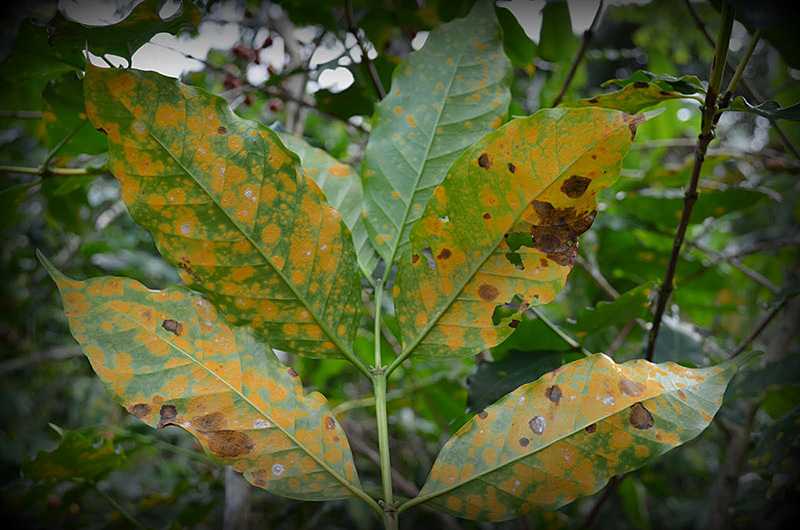KAMPALA, Uganda – The following is an excerpt of an official statement delivered on behalf of Ministry leadership by Hon. Fred Kyakulaga Bwino the Minister of State for Agriculture regarding reports of strange Coffee Pests and Diseases.
As provided for in the NDPIII and the Agriculture Value Chain Development Strategy (2021 – 2026), Coffee is a national priority commodity that is no doubt contributing significantly to the transformation of our economy. Currently, Uganda is Africa’s top Coffee exporter with earnings of US$ 496 Million in the year 2019/2020 and US$ 559Million in the year 2020/2021 from coffee exports and recorded its highest coffee exports of 6.08 million 60kg bags in 2020/2021 up from 5.12 million 60kg bags in 2019/2020.
Uganda’s coffee production is set to increase to 8m 60kg bags in the year 2021/22. It is therefore important that as the sector coordinators, we pay close attention to potential threats to its production which include disease / pests, water stress, declining soil fertility, poor agronomic practices, poor post-harvest handling and poor logistical handling.
Over the last few months, the Ministry Leadership has been receiving reports from different farmer sources across the country complaining of strange pests and diseases affecting their coffee trees. Farmers have been reporting that their coffee trees were drying up. The initial reports were from the Toro, Buganda (Mubende), Busoga, Bugisu and Sebei sub regions. These reports were later picked up by the media as well. The Ministry Leadership immediately constituted teams with membership from NARO, UCDA, as well as the Ministry Headquarters and tasked them to conduct an emergency assessment of the complaints.
The teams returned from the field last week and confirmed that indeed there were three (03) known pests and diseases affecting the coffee plants, branches, leaves and coffee berries. The teams observed that there was high severity of coffee berry disease (CBD) and coffee leaf rust (CLR) in Arabica coffee growing areas of Sebei district while the Black Coffee Twig Borer (BCTB) was the major pest in Robusta coffee in Iganga and Namutumba districts.
The Black Coffee Twig Borer – signs /symptoms of its infestation and pest management
The Black Coffee Twig Borer is a very small, highly prolific dark and oval-shaped beetle, that is present in all Robusta coffee growing areas in Uganda. If farmers do not manage the pest in line with the established guidelines, they can lose upto 50% of their crop yield.
The first signs of infestation are yellowing of the leaves on the twigs. If an affected branch is inspected, tiny entrance holes created by the borer, usually located on the branch underside are evident. Later signs of infestation are a blackening of the stem and leaves from the entrance hole towards the tip of the twig. Wilting of twigs and branches is usually seen within weeks of infestation.
Farmers are advised to integrate three main ways of controlling the Black Coffee Twig Borer, which include; cultural, chemical and physical control measures, further elaborated below:
- Use phytosanitary measures such as cutting, chopping and burning affected plant parts (twigs, branches or stems),
- Only plant coffee shade trees recommended by MAAIF (Avoid alternate host trees of the Black Coffee Twig Borer such as Musizi (maesopsis eminii) and Musambya (markhaima platycalyx) as shade trees).
- Plant pest-free planting materials (only from UCDA-certified coffee nurseries)
- Regularly inspect coffee fields to identify any Black Coffee Twig Borer infestations and trim off affected twigs followed by immediate burning of any infested materials found,
- Avoid bushy farms by planting at recommended spacing and doing adequate de-suckering / pruning of coffee and the shade trees,
- Enhance plant nutrition through soil fertility and moisture management by mulching
- Use the beetle trap (Brocca trap) developed by NARO, and
- Use chemical spray, such as immidacloprid (sold under brand names such as Kohinor, Confidor, and Imax) to get rid of the mature beetles on what remains after cutting off and burning already dried twigs. For more effectiveness, another chemical, Tebuconazole, should be added to destroy the ambrosia fungus
My Ministry will work with the District Local Governments with immediate effect to:
- Train and sensitize farmers on the above mentioned control measures
- Provide pesticides to farmers with affected coffee trees
- Support farmers with planting materials for gap filling and expansion
Coffee Berry Disease – signs / symptoms of infection and Disease Management
Coffee berry disease (CBD) is caused by a fungal plant pathogen, (Colletotrichum kahawae), and is the most important disease in Arabica Coffee grown at higher altitudes in Uganda (over 1,600 m above sea level). The Coffee Berry Disease mainly affects Arabica growing areas and in this case was confirmed in Sebei sub-region in Uganda.
Coffee Berry Disease causes dark necrosis in spots also causing the green berries of coffee to drop prematurely. Common symptoms are; slightly sunken spots on the berry that enlarge and ultimately the entire berry becomes black. Under humid conditions, the fruiting structures on the lesions may produce pink spore masses that become white with age. Infected berries shed-off once they become diseased. If the infection reaches the beans, they become black and distorted and are unmarketable.
There are two primary methods of managing the disease and they are; cultural or preventive measures and fungicide application commonly referred to as pesticides.
The cultural methods include; pruning infected branches, destruction of infected material, removal of mummified berries, minimizing optimal microclimatic conditions for the pathogen growth.
The use of fungicides such as Theobendazoles, Tebuconazoles and copper based fungicides such as Nordox 75% EC has shown effective control of the coffee berry disease
Coffee Leaf Rust – signs / symptoms of infection and Disease Management
Coffee leaf rust is a leaf disease caused by the fungus Hemileia vastatrix. The disease occurs in Arabica districts in Uganda which are found between 1000 – 1500m above sea level
Common signs and symptoms include: small, yellowish oily spots on the upper leaf surface that expand into larger round spots that turn bright orange to red and finally brown with a yellow border. The rust patches are powdery and orange yellow on the surface later turning black. The rusted leaves fall off leaving the tree stripped bare and such trees register lower yields before dying off in a space of a few years
Coffee leaf rust can be managed by good field management practices starting with proper field preparation, use of resistant/tolerant varieties from recommended nurseries, cultural practices such as proper pruning and weeding.
Coffee leaf rust can be managed by application of fungicides. The commercial fungicide Tebuconazole is an effective pesticide on rust infected fields. A tank mixture comprising copper (5 kg of 50% Weightable Powder Copper oxychloride) plus half rate organic
fungicide (e.g. 2 kg of Chlorothalonil 75% Weightable Powder), is also suitable for controlling coffee leaf rust.
In conclusion;
- Collaborative efforts are being undertaken by my Ministry where the Ministry Headquarters is working with UCDA, NARO / NACORRI, District Local Governments, Extension Workers and the Private Sector to sensitize the farmers on early identification of these diseases and management practices for the preservation of the coffee plantations. Emergency farmer engagements and advisory field activities will be undertaken across the country in the coming days and weeks.
- Farmers are advised to keep calm as my ministry works around the clock to avoid escalation of these diseases into full scale outbreaks.
- Farmers and all other stakeholders are encouraged to call the UCDA toll free line – 0800 35 35 30, for further guidance on this matter.




















